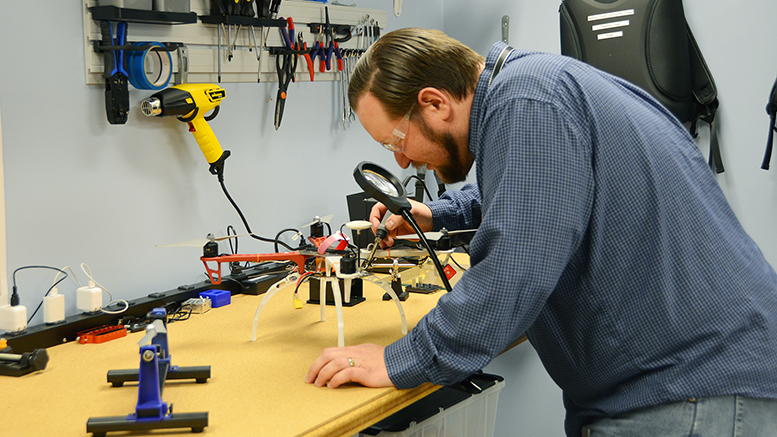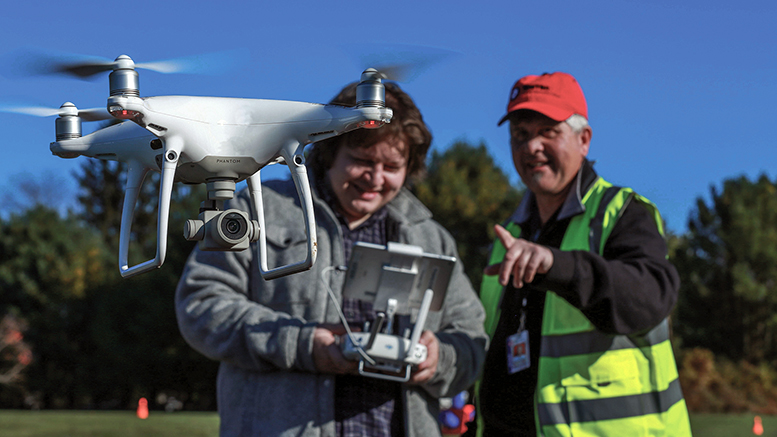The use of unmanned drone technology has taken flight in a wide array of industries, including bridge and utility line inspections, construction and land surveying, law enforcement (for use in accident reconstruction) and aerial photography.
Warren County Community College in Washington, New Jersey, got on board with the concept when it began a drone program about a year ago, and in February, WCCC became the first community college and fourth institution of higher learning to obtain a Part 107.39 waiver from the Federal Aviation Administration to be able to fly drones over people.
The two-year school joins Stanford University, University of Texas-El Paso and the Regents of the University of California in gaining this status, which fewer than 100 organizations overall have earned, says Will Austin, president of WCCC and the principal drone program instructor. Austin and his fall semester Introduction to Unmanned Systems students wrote the 380-page proposal for the waiver, which was approved on its first submission, he says, adding that organizations like Amazon and Federal Express are still working on their waiver proposals.
Plenty of blue sky
The impetus for the program, which leads to one of two certificates in piloting, or maintenance and repair, came due to WCCC’s location in a state-designated protected watershed, says Austin, a certified AUVSI TOP, Level 3 pilot.
“We had some rather severe land restrictions put in place to protect water,” he says. “That limited where development could happen and businesses could expand.”
But the one advantage of WCCC’s home turf in the northwestern corner of New Jersey is that unlike most of the state, surrounding Warren County is beyond the primary airspace of major airports in Philadelphia, Atlantic City and the New York City metropolitan region, Austin says.
“What we had going for us was airspace,” he says. “We could do things without regard for manned aircraft. We knew we could experiment and do things that you couldn’t in a more congested or populated area.”
Drone technology had the potential to lead to economic development as well as positively impacting existing industries in the rural area, Austin says.
“We have a lot of agriculture here,” he says. “We realized that drones and precision agriculture were a match made in heaven. And every job that society used to have that was dangerous is being replaced with unmanned systems.”
Those include the power line and bridge inspections. The construction industry uses the technology to monitor projects and capture images. Other uses include finding natural disaster victims and fugitive criminals.
“A lot of our students will start with small businesses, do things like real estate, or aerial photography,” Austin says. “Pretty much any industry out there will have some way of using this technology in the future.”
Different drones for different jobs
To house the program, WCCC has built a state-of-the-art training laboratory and outdoor flight training center on its campus. Peter Miller, an unmanned aircraft systems specialist who gets drones up and running and repairs them as needed, says Warren has a fleet of 42 drones of many different varieties.
“The higher-end drones, the drones that are truly professional aircraft, they do all have their specialties,” says Miller, who also helps Austin prepare for classes and acts as a teaching assistant. “That has to do with the way the drone flies, what is the nature of that drone as an aircraft, but also what kind of payload does that come with.”
While more basic drones shoot simple photography and video, some are more specialized, Miller says. Those include drones with multi-spectral cameras, used in agricultural work to read the health of plants and soil, so farmers know when they need to fertilize or water a portion of their fields. They can be used in tandem with smart tractors that “know” where they should and should not drop fertilizer as a result of the camera imagery.

First-year student James Unterwald solders a connection on a multi-rotor drone he is building in the school’s UAS lab.
Other drones have thermal imaging cameras used in industrial inspection work, to detect leaks in roofs, for example, or heat loss in different types of machinery. They also can serve in search-and-rescue missions.
WCCC has a couple of large, fixed-wing drones that are probably the most sophisticated in that they can change their payload and be repurposed for 12 different types of work, depending on the camera and sensor. One of those options is for 3-D modeling of a building, taking 200 photos while collecting GPS data that software can knit together, enabling students to virtually “walk around” the building on their computers, Miller says.
Students have come from various backgrounds, some for the piloting certificate and some for maintenance and repair.
“Obviously, these crash. Somebody has to know how to fix them,” Austin says. “I’m getting people who already have a master’s degree or already are in a profession.”
“We have a lot of returning adult students in the program. We have a number of people taking it for general interest. We have a lot of entrance and exit points,” he continues. “There are people who want the technological aspects for their existing career. There are people who want to go into this and make it a career.”
A growing industry
Austin receives calls constantly from employers looking for help.
“Power companies need drone operators desperately. They recognize the value,” Austin says. “There’s lots of people out there with a (drone) license, but there isn’t a lot of what I would call professionalism. A lot of what we try to do with this degree is turn people into professionals.”
That has a great deal of value for a power company or a construction company, given the liability they hold, Austin says.
“They need somebody they can trust with this equipment,” he says. “They’re responsible for the safety and security of people on the roadways, other people nearby, and aircraft in the sky. They want professional people who are taking this seriously because they could get sued and lose their entire business.”
Austin is optimistic the WCCC program will continue to grow and evolve as the technology does.
“If you’re interested in something that is ever-changing, this is it,” he says. “It’s the same technology as in driverless cars — they’re already learning about ground vehicles in that regard. We also do things underwater.”
And given water’s importance to the region — and to the future, in general — that’s another aspect of drone technology that excites Austin.
“Whenever students ask me what field to go into, I always say, ‘water management,’” he says. “Environmental and conservation careers are the way to go. We want to make sure that the plants of the future grow, or that people have water to drink. That’s one of the things that this technology ultimately will be used for.”
Next fall, students will learn about drone use in the military from a visiting faculty member who works for a defense contractor and has experience reverse engineering enemy drones, Miller says.
“He knows everything about a drone, backward and forward,” he says. “I’ve heard from students who are extremely excited about that. They’re saying, ‘Why can’t you start that in the summer? Why do you have to wait until the fall?’”

